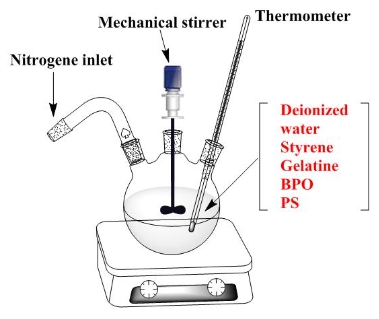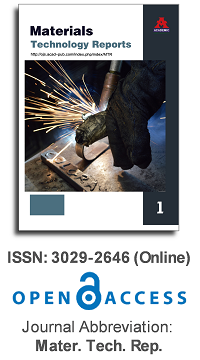
University of Chile, Chile






Materials Technology Reports (MTR) is an open access journal of related scientific research and technology development. It provides a forum for the publication of reviews, regular research papers (articles), and short communications on fundamental science, engineering, and practical applications of materials. Our aim is to encourage scientists to publish their experimental and theoretical results in great detail. Therefore, there is no restriction on the length of the papers. The full experimental details must be provided so that the results can be reproduced.
 Open Access
Open Access
Article
Article ID: 2951
by Razu Shahazi, Mashrufa Akther, Joy Malo, Mahajabin Dayna, Joya Paul, Md. Rahim Uddin, Md. Mahmud Alam
Materials Technology Reports, Vol.3, No.1, 2025;
Sodium-ion (Na-ion) batteries are becoming more popular as a budget-friendly and eco-friendly substitute for lithium-ion batteries, thanks to the plentiful supply of sodium and its reduced raw material expenses. Recent developments in sodium-ion battery research have concentrated on enhancing the performance of crucial elements such as cathodes, anodes, and electrolytes. Important advancements have been achieved in the creation of high-capacity cathodes, including layered transition metal oxides, Prussian blue analogs, and polyanionic compounds, as well as anode materials like hard carbon and alloy-based compounds. Research on electrolytes, including solid-state and ionic liquid options, aims to improve ionic conductivity, cycle stability, and prevent issues like dendrite formation. Although sodium-ion batteries generally have a lower energy density compared to lithium-based batteries, they exhibit significant potential for large-scale uses such as grid energy storage, where cost and cycle life are more important than energy density. This review highlights recent breakthroughs in Na-ion technology and discusses the growing prospects for its commercialization in the near future.
 Open Access
Open Access
Article
Article ID: 2851
by Changyou Liu, Jian Zhou, Jinshan Lu
Materials Technology Reports, Vol.3, No.1, 2025;
Granite sludge from the cutting and polishing of granite blocks should be utilized to prevent environmental pollution. This study focuses on the preparation of high-strength self-glazed glass-ceramics from granite sludge by combining dense sintering and instant glaze firing. Thermal analyses including thermogravimetry, differential scanning calorimetry and thermal expansion were used to evaluate the sinterability of the granite powder and to determine the dense sintering temperature. For the instant glaze firing of the sintered glass-ceramics, the structural evolution was analyzed by X-ray diffraction and solid-state nuclear resonance to clarify glaze formation and glass network stability, respectively. Glaze formation resulted from the dissolution of quartz and feldspars and the reduced glass viscosity, as indicated by the thermochemical calculation. As the glaze firing temperature was increased, the thickness of the surface glaze increased. The coefficient of thermal expansion of the glazed glass-ceramics indicates a residual compressive stress in the surface glaze. The elimination of glaze pinholes was achieved by reducing the amount of ferrous minerals and increasing the glaze firing rate. Under the optimum conditions, the flexural strength and surface glossiness of the glazed glass-ceramic were 112.5 MPa and 54.7 GU respectively, enabling the scalable production of high-strength self-glazed glass-ceramics from granite sludge for application in decorative tiles.
 Open Access
Open Access
Article
Article ID: 1400
by Figen Aynali, Gizem Urtekin, Levent Aydın, Huseyin Balci, Metin Cetin, Guralp Ozkoc
Materials Technology Reports, Vol.3, No.1, 2025;
In this study, the primary goal was to combine surface modification and 3D printing technology to create materials with anti-biofilm action. In order to achieve this, first a two-step reaction procedure using ring-opening copolymerization and copper(I)-catalyzed azide-alkyne cycloaddition click reaction was used to successfully fabricate poly (lactic acid) (PLA) bearing quaternary ammonium salt (QAS) as an antimicrobial agent on its backbone at rates of 5% by mole. Then, this synthesized PLA-based (co)polymer dissolved in acetone with a weight percentage of 30% was used to coat 3D-printed PLA by dipping for 10, 30, and 90 s. These coated samples encoded PLA/10/PLA-QAS, PLA/30/PLA-QAS, and PLA/90/PLA-QAS, respectively. The coated PLA scaffolds were then characterized by Fourier transform infrared spectroscopy (FT-IR) and scanning electron microscopy (SEM). Gram-positive (Staphylococcus aureus) and Gram-negative (Escherichia coli) bacteria were used to assess the anti-biofilm activity of the samples. In addition, the thermal and mechanical properties of the samples were examined through differential scanning calorimetry (DSC) and three-point bending tests, respectively. Consequently, covering the 3D-printed PLA surfaces with synthesized antimicrobial polymer prevented the formation of biofilms against both bacteria, and all coated samples showed no toxicity in 25% and 10% extraction mediums. And, it was observed that the antimicrobial polymer solution had a plasticizing effect on the PLA scaffold. As the dipping times increased, the glass transition temperatures of the coated samples decreased. In terms of flexural behaviors, increasing the dipping time also improved the flexural strain of coated PLA scaffolds. These thermo-mechanical results are correlated with SEM morphologies because of the penetration and solution effect of antimicrobial polymer dissolved in acetone.
 Open Access
Open Access
Article
Article ID: 2109
by Esteban Euti, Luciana Morel, Fernanda Stragliotto, Guillermina Luque, María Victoria Bracamonte
Materials Technology Reports, Vol.3, No.1, 2025;
The efficient and sustainable removal of organic dyes from wastewater remains a critical environmental challenge. In this study, cow hair, an abundant and underutilized agricultural waste, is transformed into biochar through a simple pyrolysis process to develop an effective and eco-friendly adsorbent for methylene blue (MB) dye removal. The physicochemical properties of the cow-hair biochar, including its surface area, porosity, and functional groups, were systematically analyzed to understand its adsorption performance. Batch adsorption experiments were conducted under varying conditions of pH, initial dye concentration, contact time, and pH to evaluate the adsorption efficiency of cow hair biochar. The results revealed that the biochar exhibits superior adsorption capacity for MB, driven by a combination of electrostatic interactions, π-π stacking, and surface oxygen functional group interactions. Using R2 as criteria, the best-fitting model was the Temkin isotherm, indicating a monolayer adsorption process with a maximum adsorption capacity surpassing many conventional adsorbents, achieving high levels of MB adsorption capacity of 730 mg/g. This study highlights the potential of converting cow hair waste into a high-performance adsorbent, offering a cost-effective and sustainable solution for dye-contaminated wastewater treatment. The findings pave the way for innovative waste valorization strategies and contribute to the advancement of green environmental technologies.
 Open Access
Open Access
Review
Article ID: 2305
by Lei Li, Fanmin Kong, Ang Xiao, Ziling Zhang, Hao Su, Xiaolian Wu, Yutian Duan
Materials Technology Reports, Vol.3, No.1, 2025;
Ziegler-Natta (Z-N) catalysts hold great significance in the industrial production of ultrahigh molecular weight polyethylene (UHMWPE), given that their outstanding efficacy, profound impact on the molecular weight (MW) of UHMWPE, and extensive industrial applications are highly conspicuous. However, the UHMWPE prepared by Z-N catalyst is usually highly entangled. Considering chain entanglement is essential for altering the processability and mechanical characteristics of nascent UHMWPE, the synthesis of disentangled UHMWPE (dis-UHMWPE) is essential for industrial scalability, therefore holding considerable practical importance. This review summarized recent progress in optimizing Z-N catalysts for the synthesis of dis-UHMWPE, providing a comprehensive overview of research advancements, clarifying polymerization settings, linking polymer structure and activity, and introducing design principles for polymerization techniques. Moreover, the overarching objective is to reveal the principles behind material preparation methods and potentiate the application prospects of UHMWPE materials, therein propelling the advancement of related fields.
 Open Access
Open Access
Review
Article ID: 2325
by Victor J. Law, Denis P. Dowling
Materials Technology Reports, Vol.3, No.1, 2025;
The study brings together in a single publication the phase-space projection analysis of microwave-assisted synthesis of transition monometallic (palladium, silver, platinum, and gold), binary zinc oxide, and metals supported on carbon framework nanostructures. It is shown for a database of fifty microwave-assisted syntheses, a two-variable power-law signature (y = cxn) over four orders of magnitude. The purpose of this study is therefore to identify the underlying dynamics of the power-law signature. A dual allometry test is used to discriminate between transition metal period and row, and between recommended Green Chemistry, problematic Green Chemistry, and non-Green Chemistry hazardous solvents. Typically, recommended Green Chemistry exhibits a broad y-axis distribution within an upper exponent = 1 and lower exponent = 0.5. Problematic Green Chemistry exhibits a y-axes narrower distribution with an upper exponent = 0.94 and a lower exponent = 0.64. Non-Green Chemistry hazardous data shows a further narrowing of the y-axis distribution within upper exponent = 0.87 and lower exponent = 0.66. Mass-based environmental factor is used to calculate the ‘Greenness’ of single-step (facile) transition metal synthesis. The power-law signature also exhibits phase transitions associated with microwave applicator type.